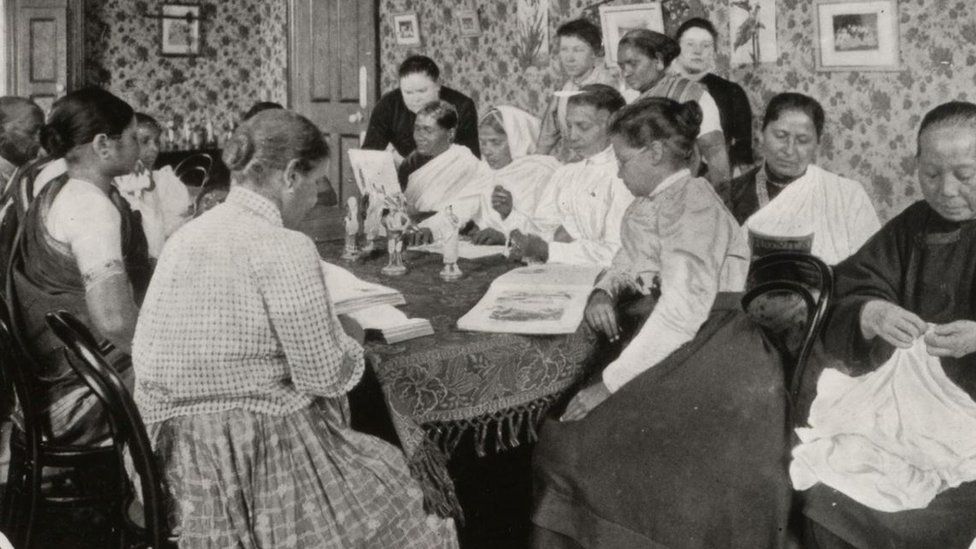ARTICLE AD BOX
By Gaggan Sabherwal
South Asia Diaspora reporter, BBC News
 Image source, British Library
Image source, British Library
The Ayahs' Home housed hundreds of destitute caregivers
During the heyday of the British empire, thousands of women from India and other parts of Asia were brought to London to look after young children - but many of these nannies were later abandoned and left to fend for themselves. Now, a building in London which housed them is set to be commemorated with a blue plaque.
The blue plaque scheme, run by the UK charity English Heritage, honours buildings across London that have been closely associated with important historical figures.
Several Indians - including independence leader Mahatma Gandhi, the country's first prime minister Jawaharlal Nehru, and the architect of its constitution BR Ambedkar - have been commemorated with the plaques. In 2020, World War Two spy Noor Inayat Khan became the first woman of Indian origin to receive a blue plaque.
The honour for the Ayahs' Home, which stands at 26 King Edward's Road in Hackney, East London, is the result of a campaign started by Farhanah Mamoojee, a 30-year-old woman of Indian origin, who first heard of the place when it was briefly mentioned in a BBC documentary.
The building is known to have housed hundreds of destitute ayahs and amahs - as Indian and Chinese nannies were called respectively.
Ms Mamoojee, and historians who have researched the role and contributions of these nannies, now hope that the honour will help shine a spotlight on these forgotten women.
Image source, British Library
Image caption,The nannies played an important role in British history
Who were the ayahs?
Most of these women came from countries such as India, China, Hong Kong, British Ceylon (now Sri Lanka), Burma (Myanmar), Malaysia and Java (part of Indonesia).
Image source, Hulton Archive/Getty Images
Image caption,Families would often bring their ayahs back to Britain with them to look after their children
"Ayahs and amahs were basically domestic workers and the backbone of British families in colonial India. They looked after the children, entertained them, told them stories, and rocked them to sleep," says Rozina Visram, historian and author of Asians in Britain: 400 Years of History.
When these families returned to Britain, they would often bring their ayahs back with them. Some were asked to accompany the families just for the long, difficult voyage, Ms Visram says, while others were employed for a few years.
"These nannies were usually provided with a return ticket back home at the expense of the family," she says.
But not everyone was as lucky - many were dismissed and abandoned by their employers without any pay or arrangements for their passage back home. Some were also forced to stay on because they couldn't find families to accompany them on the return voyage.
"This led to the ayahs being forced to fend for themselves," says Florian Stadtler, a lecturer in literature and migration at the University of Bristol who has worked with Ms Visram on the topic.
Image source, Hulton Archive/Getty Images
Image caption,An ayah with a child in India around 1858
He says that these women often took out advertisements in local newspapers, asking for help to travel back home - with many forced to take refuge in squalid accommodation which charged high rent.
"And when their money ran out, these women were thrown out of these lodging houses too. Many were even forced to beg for their journey back home to India."
The Ayahs' Home
According to the Open University's Making Britain research project, the Ayahs' Home "appears to have been founded in 1825 in Aldgate" by a woman named Elizabeth Rogers. After her death (it is not clear which year this occurred), the home was taken over by a couple who advertised the place as a lodging house for travelling ayahs.
They ran the house almost like an employment exchange, and families would come here to find nannies.
By the second half of the 19th Century, as the empire grew stronger, travel between England and India became more regular - and the number of nannies travelling to Britain also increased.
"Every year up to 200 ayahs stayed at the Ayahs' Home. Some stayed for a few days whereas some stayed for months," Dr Visram says.
The ayahs didn't pay for their accommodation. The home, Dr Visram says, received donations from local churches. There were also nannies who had return tickets but couldn't go back home due to lack of funds or an escort - in these cases, the matron of the home sold that ticket to another family which needed their services for the voyage to India, which also helped raise some funds.
Image source, Gaggan Sabherwal/BBC
Image caption,The building at 26 King Edward's Road in Hackney, East London
But the Ayahs' Home was not just a hostel or refuge.
Dr Stadtler says that one of its main objectives was to try to convert the ayahs to Christianity.
"But we don't know how many of these nannies actually converted to Christianity as there are no records of this. Nor are there any records to confirm that these ayahs were indeed forced to convert to Christianity in England," he adds.
In 1900, the home was taken over by the London City Mission, a Christian group - they shifted the lodging house first to 26 King Edward's Road in Hackney and then in 1921 to 4 King Edwards Road.
Image source, Credit unkown
Image caption,An ayah in Britain pictured with two children in an undated photo
The journey to a blue plaque
With the collapse of the British empire in the mid-20th Century, the need for ayahs and amahs dwindled. The building at 4 King Edward's Road was converted to a private residence.
Ms Mamoojee first heard about the Ayahs' Home in 2018 when she was watching a BBC documentary called A Passage to Britain which made a brief reference to the lodging house in Hackney - close to where she lived.
Image source, The Print Collector/Getty Images
Image caption,With the collapse of the British empire, the need for ayahs and amahs dwindled, and so did their numbers
"As a South Asian woman living in East London, I felt connected to the ayahs and their untold stories," she says, adding that she decided to visit the building.
"The fact that there was absolutely nothing there to say it had been such a significant place for many Asian women from all over the world left me outraged and I really felt I had to do something about this."
So she set up the Ayahs' Home Project, which documents the history of the caregivers. She also applied for a blue plaque status for the home.
In March 2020 - while she was waiting to hear from English Heritage about the status of her application - Ms Mamoojee organised an event at the Hackney Museum exploring the role of ayahs during the British empire.
Inspired by her enthusiasm, the museum staff also began researching the topic.
Image source, Hulton Archive/Getty Images
Image caption,An Indian ayah with two children circa 1850
Niti Acharya, the manager of the museum, says she tried to identify the people who stayed at the home by looking at "a range of sources, including passenger lists of people arriving in and leaving the UK from 1878 to 1960, census registers, and many archival sources".
"All the different sources help piece together small parts of the story to build up the overall picture," she says.
But it was a challenging task as there is little information available on the nannies.
"The archive material available is mainly about the families who had ayahs and amahs rather than the women themselves. Often the woman's identity is completely erased by using Christian names [for the ones who converted to Christianity] or the family name, such as 'Ayah Bird'," she says.
The blue plaque, Ms Mamoojee and others hope, could help make these forgotten women more visible.
"These women truly deserve this honour," Ms Mamoojee says.

 2 years ago
28
2 years ago
28








 English (US) ·
English (US) ·